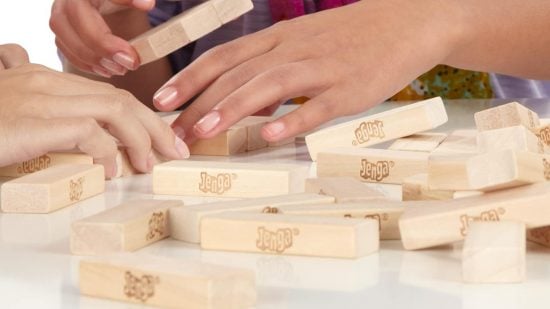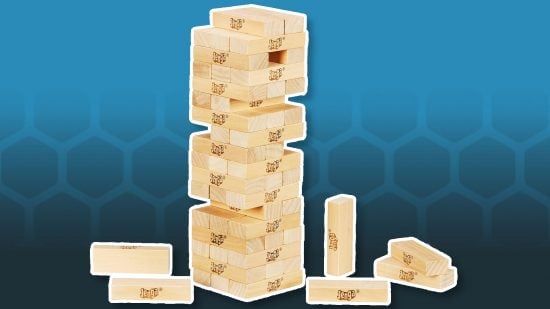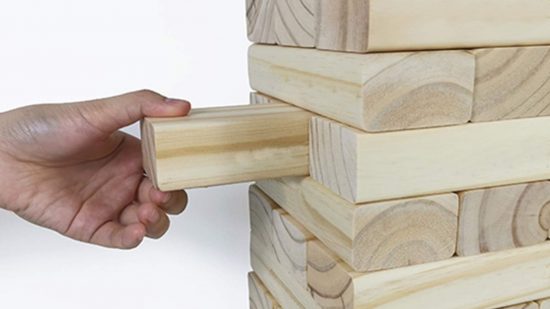This guide is for anyone out there who has found themselves staring at a pile of oblong wooden blocks, wondering exactly how to play Jenga. It’s also for anyone arguing about the Jenga rules – can you abandon a block after you’ve touched it, for example? Can you switch hands during a pull?
Before your tower starts toppling, don’t panic. We’re here to settle all things Jenga. It’s one of the best board games for parties, families, and steady hands, so it’s worth taking a bit of time to get the rules right. We can also help you with plenty of other classic board games, if you’re keen – stick around and learn how to play chess or how to win Monopoly, why don’t you?
But anyway, here’s how to play Jenga:
Jenga setup
You can play Jenga with any number of players, and the only thing you need to play is a tower of wooden blocks. Before the game begins, you’ll need to build that tower.
If you’ve put your Jenga tower away in its box, you should be able to open the top, flip it upside down, and gently pull away the packaging. Boom – instant Jenga tower. You can, of course (and might find it easier) to build the tower manually.
Start by laying three Jenga blocks next to each other. Then lay three more on top, but ensure these are rotated 90 degrees. For example, if the bottom row of blocks were laid horizontally, the next row up should be vertically placed. Continue building rows of three on top of each other, alternating their placement each time.
Once you’ve used all your blocks, take a moment to straighten the tower if it looks a little untidy. You want a strong, stable tower for the beginning of the game.
How many pieces are in Jenga?
A traditional Jenga tower comes with 54 wooden blocks. Each block is about 7.5cm long, 2.5cm wide, and 1.5cm thick. When stacked, a Jenga tower has 18 layers.
These blocks are usually blank, but some variants of the game may write dares, questions, or other information on the blocks, to be read when pulled. For now, we’re going to focus on the rules of the original game of Jenga.
Jenga rules
Usually, the person who built the tower takes the first turn. If multiple people helped build it (or you just want to shake things up), you can use any method to determine the first player that you like.
On your turn, you must pull a single block from the tower. It can be from any level – except the very top. You must use a single hand to pull this block. Having two hands on the tower at once is against the rules.
Once you’ve pulled a block from its place, you must place it on top of the tower. Since you’re starting a new row, you’ll place it at a right angle to the row below (horizontal follows vertical, and so on). Your turn ends when the next person touches the tower or ten seconds have passed.
If at any point during your turn the tower collapses (including the ten seconds after you placed your block), you have lost the game. In some versions, the last person to successfully add a block to the tower is declared the winner, but you may choose instead to declare everyone except the person who toppled the tower a victor.
Frequently asked questions
Here’s a few explainers for the minute rules of Jenga:
What happens if only one block falls in Jenga?
Even if just one block falls during your turn, it’s game over. It doesn’t matter whether a Jenga tower’s collapse is partial or full – though a full collapse is much more dramatic.
Can you touch two blocks in Jenga?
You are allowed to gently tap any number of blocks to determine how easily they can be pulled. However, when one block is moved significantly from its original position, you must either:
- Push it back into place
- Commit to pulling the block out fully
Hasbro’s official Jenga rules do state that you should put tapped blocks back in place only if it would not cause the tower to fall. So if you think tidying up is going to lose you the game, you’re allowed to abandon that block you tested.
What is the 10 second rule in Jenga?
After you place a block, the 10 second rule dictates how much time is left before your turn is over. If another player touches the tower before the ten seconds is up, they end your turn early.
It’s wise to let other players’ 10 seconds run out in a game of Jenga – if your opponent has a very unsteady tower at the end of their turn, there’s a chance it could fall on your turn if you touch it too early.
Can you switch hands in Jenga?
Only one hand can touch a Jenga tower at a time, but it can be either hand. If you wanted to switch which hand that was, this would be OK.
For more tutorials, here’s how to play Backgammon and how to play dominoes. We can also teach you about more modern strategy board games, here’s a beginner’s guide to the Gloomhaven board game.
Source: Wargamer






